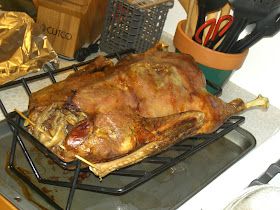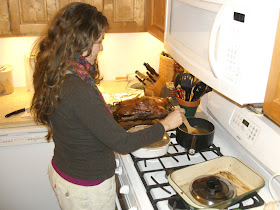So I went to the Q&A with Staten Island historians at the
New Dorp Moravian Church this past Saturday expecting to have a blast. I drew up a list of questions that I edited down to about half a dozen and was all set to go. All would have helped me clarify things I've put up or am planning to put up on the site. It should have been great.
The first thing when I got there was I saw it was going to be packed. Every parking spot was filled and I was half expecting my fellow late arrivals to start pulling up along the headstones. Cars of old people just circled around aimlessly and blocked other cars from their own terminal orbits of the lots. Finally I just slipped my little Honda Fit in alongside a building at the back of the church property, met my friend Steve McD. and went inside.
Going in I knew the audience would be skewed older. It was; it was skewed right past old into elderly. If there were more than a dozen people under sixty five in attendance I would say Staten Islanders must age terribly.
It's a shame because younger Staten Islanders are the people who are going to need to remember the borough's past. The problem, I guess, is that too many belong to families with no connection to the borough's distant past let alone the pre-bridge past or even the seventies and early eighties. Too many really have a past in Brooklyn and don't hold a nostalgic conception of Staten Island.
I don't know how you develop a love for history because no one ever had to do it for me. I was always obsessed with understanding what used to be somewhere and how whatever happened did. When teachers or my grandparents started telling stories I just sat there, listened and thought up questions to ask. I also can't understand how people aren't as fascinated as I am. I mean I can, it's just that it makes me a little sad.
Surrounding the folding chairs set up in the church auditorium (a beautiful building marred by dirty acoustic tile ceiling.) were tables from all the Staten Island historical groups;
the Staten Island Museum,
the Alice Austen House,
the Tottenville Historical Society,
the Staten Island Historical Society,
the Conference House and
the Jacques Marchais Tibetan Museum. Cool, I thought, I could get some information from them at the end and find out how to get access to their archives. We signed in and grabbed two of the last remaining seats. This was gonna be great.
So the organizer, got up, and in an unfortunate monotone, explained how the event would proceed. Instead of getting to the questions from the audience, representatives of the cultural organizations would get up and make presentations. Yes, a crowd of Staten Island history aficionados would get to hear people talk about Richmondtown, Alice Austen and the Conference House yet again. If the guy from the Conference House in his colonial get-up talked in an old-timey voice I thought I might scream.
He didn't but it was almost as bad. The woman representing the Alice Austen House, in the least interesting sort of community theater acting style, pretended to BE Alice Austen. I had questions to ask and there was bad acting going on about stuff everybody already knew.
When Conference House representative spoke he didn't use an old-timey voice, just a Staten Island one. I wish he had gone for the former. It mightn't have been as disconcerting.
What should have been a great event with all sorts of beautifully inane and pointless questions that should compose the best trivia sessions we got a set of ads for the pretty much the same old boring organizations. Nobody on Staten Island needs to hear anything else about the Voorlezer House. Ever.
Sure it's cool they've saved colonial buildings and moved them to Richmondtown, but I don't care anymore. Tell me about Port Richmond or Mariners' Harbor in the twenties or the old theaters in Stapleton. Tell me about the founding of the New Brighton neighborhood around Franklin Avenue. Just don't tell me about the same old junk I've been hearing since I was five.
To step off for a moment, I will say the Tottenville representative was pretty interesting. Her group's new and recently did a great thing. Through a series of events she didn't elaborate on they discovered the neglected gravesite of the Rev. John Lenhard (spell). He was a naval chaplain and was killed in the sinking of the
USS Cumberland by the
CSA Virginia at Hampton Roads in 1862. With music and representatives from the navy, they rededicated his grave. Very cool and the exact sort of stuff historical societies should be doing.
Finally we got to the questions. This was what I was waiting for and it was pretty cool. The first question concerned the name of the old movie theater on Victory Blvd. (The Victory!) and the second was about a Chilean racehorse buried at Fort Wadsworth.
One man asked the name of the Indian tribe on Staten Island at the time of the Dutch arrival and I could sense everyone else in the audience saying "Leni Lenape" sotto voco. The panelists did, then, enter into a informative and un-boring discussion about the tribes, known burial sites and the fact that they were part of a trade network that extended from Florida to Canada.
Finally I was called on but the man in front of me took the emcee's pointing hand as his cue to jump up and make more of a statement than ask a question. He wanted there to be more of an emphasis on Staten Island's abolitionist and underground railroad history. The panelists all agreed with him, but, and particularly the borough historian, took the opportunity to make clear that too much of accepted Staten Island history is hearsay. While it's true that many notable abolitionists lived the Island (
George William Curtis,
Robert Gould Shaw, the Goodhues, the Jewetts, and numerous others), there's little concrete evidence of underground railroad activity. He stressed that doesn't mean it didn't happen but there needs to a be careful search for any possible proof and it's examination.
Then I asked my question. With the large crowd and long delay I had been paring my page of questions down to a single one. I settled on the most obscure one, the one I felt unlikely to find an answer to anywhere else. The picture of the ex-German church on York Avenue indicates it was converted to something called "The Bill Smith Club." I asked and was greeted by silence. The panelists looked dumbfounded and didn't even seem to know exactly where I was talking about. Then the oldest member spoke up.
"The Smiths were a family who lived on Prospect Avenue across from the old PS 17. They had about sixteen kids. It was a political club." His answer was clear without hesitation.
Instead of asking what party it was (though I assume Democratic), I did manage to ask if he knew when the building came down. He didn't, just that it had.
And then it was over. It was getting late and I had to visit my aunt in the hospital. My friend's legs were bugging him and he decided it was time to go too. So we left and while I got some decent information and got a cool question answered I was disappointed. Too much time had been wasted with promos for groups that didn't need any with the nature of the assembled crowd. People had come out in their white haired droves to ask burning questions about borough trivia. They didn't need another round of commercials.







































